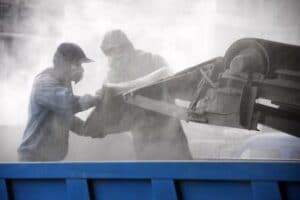
I enjoy drawing similarities of theories in other disciplines to safety, in this case there’s one in criminology referred to as the Broken Window Theory. It states that if a window in a building is broken and is left unrepaired, all the rest of the windows will soon be broken. This is because one un-repaired broken window is a signal that no one cares, and so breaking more windows costs nothing. We can draw a similar relationship between good housekeeping and safety culture maturity. When a workplace has a high standard of housekeeping, our first impression is usually that of good management of not only safety but all other elements of the business. Conversely, poor housekeeping gives an impression of poor corporate culture in which focus is placed on the bottom line at all costs.
Housekeeping entails more than just cleanliness and is an essential aspect for any safety management program. Poor housekeeping amplifies other hazards present in the workplace through;
· Tripping over uneven surfaces eg. Potholes,
· tripping over loose objects on floors, stairs and platforms
· being struck by falling objects
· slipping on oily, wet or dirty surfaces
· Impact against projecting, poorly stacked items or misplaced goods
· cutting, puncturing, or tearing of the skin on projecting nails or wires
A good housekeeping program promotes the orderly storage of goods and movement of items through the production cycle. This alone can improve efficiency of the work process which in turn offsets any costs involved in implementing the program. It is important to note that good housekeeping is not achieved but it is maintained.
An effective housekeeping program should capture the following elements,
Surfaces

Poor floor conditions are made up of a combination of spills, uneven surfaces, items on the floor, accumulation of dirt, poor carpeting amongst others. Floors should be kept free of the mentioned conditions to mainly reduce slips and trips. Another surface is the walls. Contrasting colours on walls warn of physical hazards and mark obstructions such as pillars. Bright Paint is also used to highlight railings, guards and other safety equipment. The program should therefore have a colour code to assign meaning to colours. Poorly maintained walls obscure the colour and therefore the warnings depicted might be difficult to interpret.
Gangways & Stairs

Depending on the operations, gangways should be wide enough to ensure safe passage of people and vehicles. Proper marking of designated gangways promotes their safe usage and discourages people from taking shortcuts through hazardous areas. The gangways and stairs should be maintained free of obstruction and should not be used for temporary storage of goods. This aspect is also highlighted in Fire Safety with respect to evacuation procedures.
Maintenance

From the above-mentioned broken window theory, we can deduce that maintenance may be the most important element of good housekeeping. A good maintenance program includes constant facility inspection and immediate remedy (Repair or Replacement) of any observed faults.
Dusting

This seeks to prevent the accumulation of dust in the premises. In workplaces where dust exposure is high, it is recommended that the occupier undertakes an Air quality Survey. This will help ascertain the exposure levels and inform control measures. Dust affects visibility in the workplace. This is through accumulation in light fixtures and also atmospheric. In addition, Dust accumulation contributes to expensive equipment failure.
Spillage Control

Prevention of spills is the most effective mode of spill control. However when spills occur it is very important to ensure they are cleaned up immediately. The various materials used to contain the spillage should be well cleaned or disposed according to environmental guidelines.
Waste Disposal

Regular waste collection, sorting, and transfer to a disposal site contribute to good housekeeping. The program should ensure the provision of adequate disposal bins which are labeled to promote segregation.
All workers should be involved in the maintenance of good housekeeping especially when it comes to individual workstations. Training on housekeeping should be undertaken regularly to ensure workers safely handle the products available. Formal assignment of duties will further promote accountability for the effective running of the program.
Housekeeping issues are very common and for the most part, easy to fix. The main issue is the consistency of action that poses a challenge in maintaining good standards. What other elements of effective housekeeping do you use that can be added to my list? Comment below.
References
Canadian Centre for Occupational Health & Safety. (2018, June 4). Workplace Housekeeping – Basic Guide. Retrieved from CCOSH: https://www.ccohs.ca/oshanswers/hsprograms/house.html#:~:text=Housekeeping%20is%20not%20just%20cleanliness,fire%20hazards%20from%20work%20areas.&text=Good%20housekeeping%20is%20also%20a%20basic%20part%20of%20incident%20and%20fire%20prevention.
Trotto, S. (2015, July 1). 11 tips for effective workplace housekeeping. Retrieved from Safety+Health: https://www.safetyandhealthmagazine.com/articles/12470-tips-for-effective-workplace-housekeeping?page=2
Wikipedia. (2021, February 18). Broken windows theory. Retrieved from Wikipedia: https://en.wikipedia.org/wiki/Broken_windows_theory
